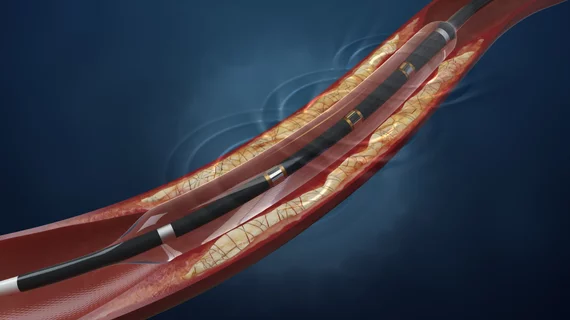Multicenter trial to evaluate IVL treatment for peripheral lesions below the knee
Shockwave Medical has started enrolling patients for its new post-market study exploring the safety and effectiveness of its intravascular lithotripsy (IVL) technology as a treatment option for heavily calcified peripheral lesions below the knee.
The company plans on enrolling 250 patients overall for the Disrupt BTK II multicenter, single-arm study. Investigators will follow patients from 40 different sites for two full years to see how they respond to treatment with the Shockwave Peripheral IVL System. Major adverse limb events after 30 days will be a primary focus of the study.
Ehrin Armstrong, MD, medical director and interventional cardiologist at the Adventist Heart & Vascular Institute, and Venita Chanda, MD, a vascular surgeon and clinical professor at Stanford Health Care, are leading the study together.
“Patients with severely calcified, diffuse below the knee disease, and especially those with critical limb ischemia, are often in severe pain with limited treatment options to achieve adequate arterial revascularization,” Armstrong said in a prepared statement. “The unmet clinical need for this population is extremely high. Disrupt BTK II will further evaluate how IVL may be optimally used to treat patients who have historically been excluded from most endovascular treatment trials.”
“We already know that IVL can reduce significant dissection as well as reduce the need for provisional stenting over conventional percutaneous transluminal angioplasty in peripheral vessel beds, but what makes Disrupt BTK II even more exciting is that we are now isolating the treatment effect to get a clearer picture about what role IVL can offer as a definitive therapy for these very complex patients,” added Chandra.
Related Content on Intravascular Lithotripsy to Break Up Calcified Lesions:
VIDEO: Shockwave Medical demonstrates faster intravascular lithotripsy at ACC22
Shockwave’s IVL technology gains FDA approval for treating advanced coronary artery disease
Better Together? An Integrated Market for Calcium-modification Strategies
IVL Turns Standard Balloon Technology into a Powerful Calcium-disruption Tool
CMS recommends additional payment for using Shockwave’s IVL technology in hospital setting

